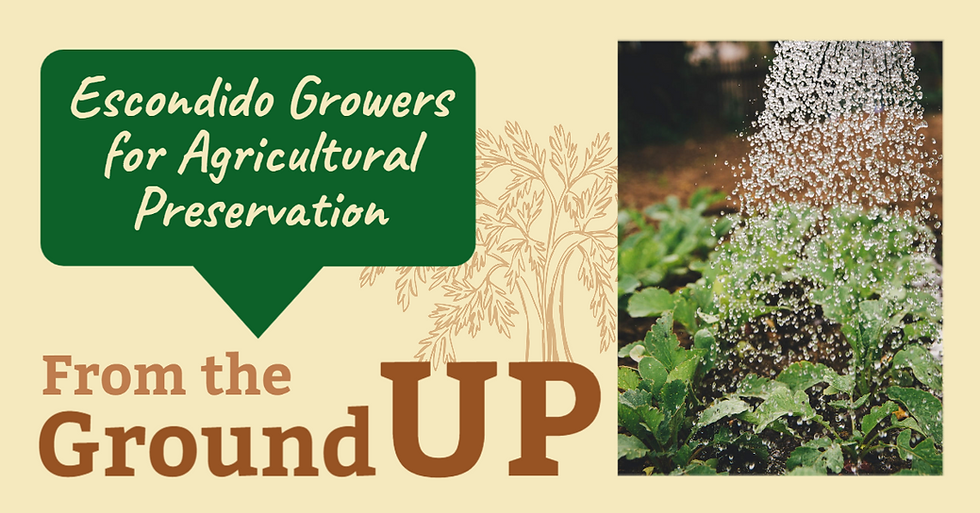A Profile on the Legacy of Escondido Agriculture: Part 1
- Climate Science Alliance

- Jun 29, 2020
- 4 min read
Our next profile in the “From the Ground Up” series is a two-part story on the historical legacy of agriculture in Escondido and the importance of preserving this legacy into the future. Today in Part 1 of the series, we hear from the co-directors of the Escondido Growers for Agricultural Preservation (EGAP), Edward Grangetto and John Burr, on the historical legacy of Escondido agriculture as a pioneer and leader for the region.

As part of the 2020 Climate Change Consortium, hosted in partnership by the Climate Science Alliance and the California Department of Food and Agriculture, we are excited to share a series of producer stories, called “From the Ground Up: Farmer Profiles,” highlighting our region’s producers and the important work they do for our communities.
Our next profile in the “From the Ground Up” series is a two-part story on the historical legacy of agriculture in Escondido and the importance of preserving this legacy into the future. Today in Part 1 of the series, we hear from the co-directors of the Escondido Growers for Agricultural Preservation (EGAP), Edward Grangetto and John Burr, on the historical legacy of Escondido agriculture as a pioneer and leader of the region’s agricultural community.

Describe agriculture in Escondido. What makes it unique?
“Escondido Agriculture is unique for a number of reasons. From the early days of finding sustainable water sources for the City, the pioneering families that built Escondido’s Agricultural Community, the distinctive crops that flourish in our area and the fact that Escondido’s location provided a convenient “Ag Hub” where growers from all over San Diego Counties would come for the multiplicity of products and services that farmers require.”
“The “Ag Hub” in Escondido provided a base for businesses such as the “Tom Bandy’s Blacksmith Shop,” and the go-to place for all types agricultural inputs, e.g., Irrigation Products including Webb Pump & Supply, cement products (now RCP), Palomar Tractor, the Massey Ferguson dealer for Tractors & Implements, Grangetto Agricultural supply Co., a 68 year old business still operating today, and the all important office for farmer and rancher organizations, the San Diego County Farm Bureau, since 1913. Today the Farm Bureau is a primary draw since the facility also houses the UC Cooperative Extension Farm Advisors Program providing academic and natural resource advisors as well as nutrition educators who work with both farmers and the public. The Farm Bureau is the true hub of agriculture-related people. Lastly, Escondido is also home to the USDA Natural Resource Conservation Service, where customers can access the many government services provided by the Farm Service Agency, Natural Resources Conservation Service and the Rural Development agency.”

“The early pioneering local families such as the Wohlfords, Hillebrechts, Grangettos, Henrys, etc. contributed significantly to the techniques for growing, packing, shipping of Citrus, Avocados, Wine Grapes, etc. primary crops grown in Escondido still, today, and these family continue today to be important participants.! These crops also provided the need for the facilities to pack and process agricultural commodities at a local level. From the 1935 creation of the Escondido Orange Association Packing House, the World’s largest lemon packing house (packing over 800,000 field boxes of lemons annually) and even the early avocado industry in 1928 that lead to one of the most modern avocado packing houses (Calavo Co-op) being built in Escondido. The early avocado industry was primarily developed in Escondido, with the first plantings in 1905. Many trips were taken abroad to locate new varieties and rootstocks. Grapes were also a mainstay since the Mission days and key players were the Italian immigrant community.”
What role has Escondido agriculture played in the region’s water resources and supply?
“From the 1889 creation of the Escondido Irrigation District, formed to augment local agricultural water supplies, to our current recycled water project that will deliver prescription designed wastewater to growers throughout our region, accessible water was the key to our region’s development. Since 1970, when the City of Escondido acquired the Escondido Mutual Water Company (due to financial difficulties, the E.M.W. Company was formed in 1904 to acquire and improve the facilities of the district), a large part of Escondido’s Water Infrastructure was built with Agriculture as the driver. Even “Lake Wohlford” (formerly the Escondido Reservoir) can trace its roots to agriculture.”

“Continuing the legacy, agriculture is the partner in the first leg of Escondido’s recycled water reuse that may eventually provide purified recycled water direct human consumption. From the delivery pipe installation to the Micro Filtration - Reverse Osmosis Plant, Escondido agriculture will be the first recipient of the designer wastewater.”
Why is it important to you that agriculture continues to thrive in Escondido?
“Agriculture has been the cornerstone of Escondido‘s economy for decades. From the very early beginnings in 1888, Escondido was incorporated as a city and in 1891 the Escondido Irrigation District was organized to deliver water to a thirsty clientele. At this time, grapes were one of the most important agricultural products of the valley.
"Recently, with the creation of Escondido Growers for Agricultural Preservation (EGAP), agriculture again has retained its appropriate place on the radar of Escondido’s leadership. After years of being overlooked as a key business contributor, Escondido Agriculture is finally being recognized as the significant player that it has always been.”
Join Us:
Join us next week for Part 2 of the “From the Ground Up: A Profile on The Legacy of Escondido Agriculture” to learn how Escondido agriculture’s historical legacy shapes the region’s agriculture today, its importance for Escondido’s economy, community, environment, and regional climate solutions, and the role of EGAP in promoting sustainable and thriving agriculture for the future.
Learn More:
To learn more about EGAP and their on-going efforts to support Escondido Agriculture, visit: http://growescondido.org/. To read more about the benefits of local agriculture for our region’s climate, community, and economy, visit: www.climatesciencealliance.org/resilient-roots-resources
Agriculture in Escondido: Opportunities for Resilience - to learn more about agriculture in Escondido, created in collaboration with EGAP
2020 Climate Change Consortium for Specialty Crops Southern California - for additional project information and to access all materials, resources, and surveys.
From the Ground-Up: Farmer Profiles - to hear stories from other producers
Climate Science Alliance - to learn more about our work and other projects



